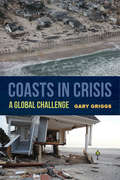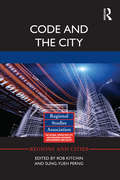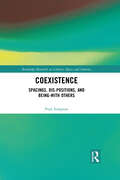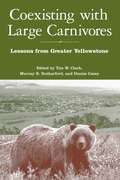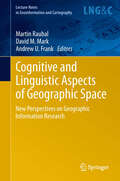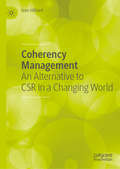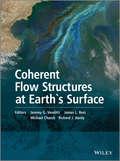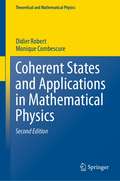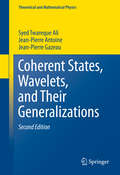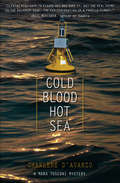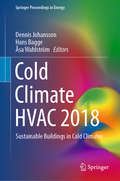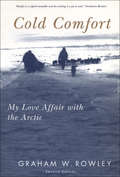- Table View
- List View
Coastlines: At the Water's Edge
by Emily NathanA wanderlust-inspiring photography collection of the world&’s most stunning waterways and coastlines from the premier online curator of travel photography, Tiny Atlas Quarterly. From tropical beaches in Hawai&’i and icy fjords in Greenland to lush mangrove swamps in the Cuban Cayos and forested islands in Vietnam, coastlines and waterways are some of the world&’s most beloved places and most precious habitats. With hundreds of awe-inspiring photos from locations far and wide, Coastlines is a visual tour of these magical watery places and a treasure trove of curated travel information. Water lovers, beach bums, and armchair travelers will enjoy this tranquil exploration of the world&’s many vast and varied shores.
Coasts in Crisis: A Global Challenge
by Prof. Gary GriggsCoastal regions around the world have become increasingly crowded, intensively developed, and severely exploited. Hundreds of millions of people living in these low-lying areas are subject to short-term coastal hazards such as cyclones, hurricanes, and destruction due to El Niño, and are also exposed to the long-term threat of global sea-level rise. These massive concentrations of people expose often-fragile coastal environments to the runoff and pollution from municipal, industrial, and agricultural sources as well as the impacts of resource exploitation and a wide range of other human impacts. Can environmental impacts be reduced or mitigated and can coastal regions adapt to natural hazards? Coasts in Crisis is a comprehensive assessment of the impacts that the human population is having on the coastal zone globally and the diverse ways in which coastal hazards impact human settlement and development. Gary Griggs provides a concise overview of the individual hazards, risks, and issues threatening the coastal zone.
Coasts, Estuaries and Lakes: Implications for Sustainable Development
by N. Jayaraju G. Sreenivasulu M. Madakka M. ManjulathaThis volume discusses geological, biological and sustainability aspects of coastal, estuary and lake environments. It offers a comprehensive understanding of biotic, physico-chemical, sedimentological and socio-environmental factors associated with the sustainable development of these environments in areas vulnerable to climate change and other anthropogenic activities. The book is divided into several main sections, covering the geological and biological processes and dynamics of these environments, water quality and hydrological modeling, sediment characteristics, bio-indicators and ecological analysis, climate change impacts, geospatial applications, and sustainable development practices and scenarios. The book aims to be a useful resource for academics, scientists, coastal and marine practitioners, meteorologists, environmental consultants and computing experts working in the areas of earth and ocean sciences.
Code and the City (Regions and Cities)
by Rob Kitchin Sung-Yueh PerngSoftware has become essential to the functioning of cities. It is deeply embedded into the systems and infrastructure of the built environment and is entrenched in the management and governance of urban societies. Software-enabled technologies and services enhance the ways in which we understand and plan cities. It even has an effect on how we manage urban services and utilities. Code and the City explores the extent and depth of the ways in which software mediates how people work, consume, communication, travel and play. The reach of these systems is set to become even more pervasive through efforts to create smart cities: cities that employ ICTs to underpin and drive their economy and governance. Yet, despite the roll-out of software-enabled systems across all aspects of city life, the relationship between code and the city has barely been explored from a critical social science perspective. This collection of essays seeks to fill that gap, and offers an interdisciplinary examination of the relationship between software and contemporary urbanism. This book will be of interest to those researching or studying smart cities and urban infrastructure.
Code of Conduct on Transnational Corporations: Challenges and Opportunities (CSR, Sustainability, Ethics & Governance)
by Mia Mahmudur RahimThis book explores the challenges and opportunities presented by the formulation of a global code of conduct for transnational corporations. It assesses the current state of research on global regulations intended to enhance the social responsibility of transnational corporations, and provides a platform for future research. In particular the book examines frameworks and instruments for regulating social responsibility, reviews recent developments concerning the proposed UN Code of Conduct on Transnational Corporations, and provides insights into international civil society groups’ movements in pursuit of a code of conduct. In a separate chapter the book discusses theoretical issues in regulating transnational corporations, and investigates their legitimacy and behavioral dynamics. In closing, the book discusses alternatives to a global code of conduct, the impact of sovereign power in the era of globalization, “soft regulations,” and the feasibility and normative efficacy of enforcing regulations.
Code of Conduct on Transnational Corporations: Challenges and Opportunities (CSR, Sustainability, Ethics & Governance)
by Mia Mahmudur RahimThis book explores the challenges and opportunities presented by the formulation of a global code of conduct for transnational corporations. It assesses the current state of research on global regulations intended to enhance the social responsibility of transnational corporations, and provides a platform for future research. In particular the book examines frameworks and instruments for regulating social responsibility, reviews recent developments concerning the proposed UN Code of Conduct on Transnational Corporations, and provides insights into international civil society groups’ movements in pursuit of a code of conduct. In a separate chapter the book discusses theoretical issues in regulating transnational corporations, and investigates their legitimacy and behavioral dynamics. In closing, the book discusses alternatives to a global code of conduct, the impact of sovereign power in the era of globalization, “soft regulations,” and the feasibility and normative efficacy of enforcing regulations.
Coexistence: Spacings, Dis-positions, and Being-with Others (Routledge Research in Culture, Space and Identity)
by Paul SimpsonThis book aims to develop an account of living together with difference which recognises the tension that we are inescapably with others – both human and non-human – but at the same time are always differing from and with those with whom we find ourselves.A concern for coexistence and questions over how we might live together have been raised and approached from a host of conceptual starting points in recent times, including via calls for a rethinking of communism today, the articulation of forms of ‘cosmopolitics’ or ‘pluralism’, the re-figuring of understandings of ecology as dark or feminist, amongst others. This book responds to such questions of coexistence by developing what it calls a ‘co-existential analytic’. In doing so, this book introduces a range of post-phenomenological thought which offers means for thinking about such questions of living together with difference. The thought of Emanuel Levinas on the face of the other, Jean-Luc Nancy on being as being-with, Roberto Esposito on the munis, and Michel Henry on pathic auto-affection are introduced and critically reflected upon in terms of what they offer for thinking about such coexistence. Alongside these conceptual starting points, a series of encounters - with cinema, everyday life, politics, and literature - are used to animate and illustration the discussion. Ultimately, the book argues for a ‘spacing’ of subjectivities with that world and those encountered within it.This book is intended primarily for researchers and postgraduate students interested in questions of identity, difference, and subjectivity. It will be of interest to those in the fields of social and cultural geography, sociology, social theory, and cultural studies.
Coexisting with Large Carnivores: Lessons From Greater Yellowstone
by Murray Rutherford Denise Casey Tim ClarkAs in the rest of the United States, grizzly bears, wolves, and mountain lions in and around Yellowstone National Park were eliminated or reduced decades ago to very low numbers. In recent years, however, populations have begun to recover, leading to encounters between animals and people and, more significantly, to conflicts among people about what to do with these often controversial neighbors. Coexisting with Large Carnivores presents a close-up look at the socio-political context of large carnivores and their management in western Wyoming south of Yellowstone National Park, including the southern part of what is commonly recognized as the Greater Yellowstone Ecosystem. The book brings together researchers and others who have studied and worked in the region to help untangle some of the highly charged issues associated with large carnivores, their interactions with humans, and the politics that arise from those interactions. This volume argues that coexistence will be achieved only by a thorough understanding of the human populations involved, their values, attitudes, beliefs, and the institutions through which carnivores and humans are managed. Coexisting with Large Carnivores offers important insights into this complex, dynamic issue and provides a unique overview of issues and strategies for managers, researchers, government officials, ranchers, and everyone else concerned about the management and conservation of large carnivores and the people who live nearby.
Coffee and Community
by Sarah LyonWe are told that simply by sipping our morning cup of organic, fair-trade coffee we are encouraging environmentally friendly agricultural methods, community development, fair prices, and shortened commodity chains. But what is the reality for producers, intermediaries, and consumers? This ethnographic analysis of fair-trade coffee analyzes the collective action and combined efforts of fair-trade network participants to construct a new economic reality. Focusing on La Voz Que Clama en el Desierto-a cooperative in San Juan la Laguna, Guatemala-and its relationships with coffee roasters, importers, and certifiers in the United States, Coffee and Community argues that while fair trade does benefit small coffee-farming communities, it is more flawed than advocates and scholars have acknowledged. However, through detailed ethnographic fieldwork with the farmers and by following the product, fair trade can be understood and modified to be more equitable. This book will be of interest to students and academics in anthropology, ethnology, Latin American studies, and labor studies, as well as economists, social scientists, policy makers, fair-trade advocates, and anyone interested in globalization and the realities of fair trade.
Cognitive and Linguistic Aspects of Geographic Space: New Perspectives on Geographic Information Research (Lecture Notes in Geoinformation and Cartography #63)
by David M Mark Martin Raubal Andrew U. Frank20 years ago, from July 8 to 20, 1990, 60 researchers gathered for two weeks at Castillo-Palacio Magalia in Las Navas del Marques (Avila Province, Spain) to discuss cognitive and linguistic aspects of geographic space. This meeting was the start of successful research on cognitive issues in geographic information science, produced an edited book (D. M. Mark and A. U. Frank, Eds., 1991, Cognitive and Linguistic Aspects of Geographic Space. NATO ASI Series D: Behavioural and Social Sciences 63. Kluwer, Dordrecht/Boston/London), and led to a biannual conference (COSIT), a refereed journal (Spatial Cognition and Computation), and a substantial and still growing research community. It appeared worthwhile to assess the achievements and to reconsider the research challenges twenty years later. What has changed in the age of computational ontologies and cyber-infrastructures? Consider that 1990 the web was only about to emerge and the very first laptops had just appeared! The 2010 meeting brought together many of the original participants, but was also open to others, and invited contributions from all who are researching these topics. Early-career scientists, engineers, and humanists working at the intersection of cognitive science and geographic information science were invited to help with the re-assessment of research needs and approaches. The meeting was very successful and compared the research agenda laid out in the 1990 book with achievements over the past twenty years and then turned to the future: What are the challenges today? What are worthwhile goals for basic research? What can be achieved in the next 20 years? What are the lessons learned? This edited book will assess the current state of the field through chapters by participants in the 1990 and 2010 meetings and will also document an interdisciplinary research agenda for the future.
Cohabiting Earth: Seeking a Bright Future for All Life
by Joe Gray; Eileen CristThe eco-catastrophes that we are witnessing today starkly demonstrate how the interests of the Earth's currently dominant species are in lockstep with those of nature's wider whole. Simply stated, humans and the more-than-human world have a shared fate. Just as humanity's unrestrained overreach in the ecosphere is driving a mass extinction event and causing the devastation of lifeforms and places, so it is also jeopardizing the prospect of a human future worth living. There is no "humans versus nature" tradeoff: the wellbeing of both is inseparably entwined. Solutions to the shared predicament of all Earth's beings will thus necessarily be those that strive for harmony between human presence and the rest of nature. This applies to the philosophy we adopt for agriculture, the ways in which human economies operate, our patterns of consumption, and numerous other intertwined threads of our existence. This anthology argues that harmony between humanity and our home planet must be built on the pillars of restraint, respect, and reverence.
Coherency Management: An Alternative to CSR in a Changing World
by Ivan HilliardThis book presents a new approach to corporate responsibility based on the concept of coherency, permitting better understanding and management of the conflicting forces that strive to create value across the stakeholder spectrum. In doing so, it provides an alternative to the limited and ineffective role currently played by Corporate Social Responsibility (CSR), and offers an approach more in line with the needs of a sustainable society. Hilliard introduces several new concepts in management philosophy and presents an innovative and original framework for managing organizational responsibilities in a coherent manner.
Coherent Control of Nuclei and X-Rays (Springer Theses)
by Wen-Te LiaoNovel coherent light sources such as x-ray free-electron lasers open exciting prospects for the interaction of light with nuclei. The thesis "Coherent Control of Nuclei and X-rays" covers this still-developing field and proposes, in a daring attempt to revolutionize nuclear physics, three innovative schemes for taming nuclei using coherent effects. The theoretical explorations, which address control of nuclear quantum states, a nuclear memory for single photons in future photonic circuits, and optimized concepts for a nuclear clock, make use of new approaches at the borderline between nuclear physics and quantum dynamics. The result is a well written work, impressive in its stimulating style and promising ideas.
Coherent Flow Structures at Earth's Surface
by Jeremy G. Venditti Michael Church Richard J. Hardy James L. BestAn expert review of recent progress in the study of turbulent flows with a focus on recently identified organized structures. This book reviews the recent progress in the study of the turbulent flows that sculpt the Earth's surface, focusing in particular on the organized structures that have been identified in recent years within turbulent flows. These coherent flow structures can include eddies or vortices at the scale of individual grains, through structures that scale with the flow depth in rivers or estuaries, to the large-scale structure of flows at the morphological or landform scale. These flow structures are of wide interest to the scientific community because they play an important role in fluid dynamics and influence the transport, erosion and deposition of sediment and pollutants in a wide variety of fluid flow environments. Scientific knowledge of these structures has improved greatly over the past 20 years as computational fluid dynamics has come to play an increasing important part in building our understanding of coherent flow structures across a broad range of scales.Chapters comprise a series of major, invited papers and a selection of the most novel, innovative papers presented at the second Coherent Flow Structures Conference held August 3-5, 2011 at Simon Fraser University in Burnaby, British Columbia. Chapters focus on six major themes:Dynamics of coherent flow structures (CFS) in geophysical flowsInteraction of turbulent flows, vegetation and ecological habitatsCoherent structure of atmospheric flowsNumerical modeling of coherent flow structuresTurbulence in open channel flowsCoherent flow structures, sediment transport and morphological feedbacks.
Coherent States and Their Applications: A Contemporary Panorama (Springer Proceedings in Physics #205)
by Fabio Bagarello Jean-Pierre Gazeau Jean-Pierre AntoineCoherent states (CS) were originally introduced in 1926 by Schrödinger and rediscovered in the early 1960s in the context of laser physics. Since then, they have evolved into an extremely rich domain that pervades virtually every corner of physics, and have also given rise to a range of research topics in mathematics.The purpose of the 2016 CIRM conference was to bring together leading experts in the field with scientists interested in related topics, to jointly investigate their applications in physics, their various mathematical properties, and their generalizations in many directions. Instead of traditional proceedings, this book presents sixteen longer review-type contributions, which are the outcome of a collaborative effort by many conference participants, subsequently reviewed by independent experts.The book aptly illustrates the diversity of CS aspects, from purely mathematical topics to physical applications, including quantum gravity.
Coherent States and Applications in Mathematical Physics (Theoretical and Mathematical Physics)
by Didier Robert Monique CombescureThis book presents the various types of coherent states introduced and studied in the physics and mathematics literature and describes their properties together with application to quantum physics problems. It is intended to serve as a compendium on coherent states and their applications for physicists and mathematicians, stretching from the basic mathematical structures of generalized coherent states in the sense of Perelomov via the semiclassical evolution of coherent states to various specific examples of coherent states (hydrogen atom, quantum oscillator, ...).
Coherent States and Applications in Mathematical Physics (Theoretical and Mathematical Physics)
by Didier Robert Monique CombescureThis second edition of the outstanding monograph on coherent states by Combescure and Robert published in 2012 is enriched with figures, historical information and numerical simulations and enlarged with five new chapters presenting important rigorous results obtained in the recent years. The new chapters include various applications such as to the time dependent Schroedinger equation and the Ehrenfest time, to the growth of norms and energy exchanges, to chaotic systems and classical systems with quantum ergodic behavior, and to open quantum systems, and to adiabatic decoupling for multicomponent systems Overall, this book presents the various types of coherent states introduced and studied in the physics and mathematics literature and describes their properties together with application to quantum physics problems. It is intended to serve as a compendium on coherent states and their applications for physicists and mathematicians, stretching from the basic mathematical structures of generalized coherent states in the sense of Perelomov via the semiclassical evolution of coherent states to various specific examples of coherent states (hydrogen atom, quantum oscillator, etc.). It goes beyond existing books on coherent states in terms of a rigorous mathematical framework
Coherent States, Wavelets, and Their Generalizations (Theoretical and Mathematical Physics)
by Jean-Pierre Gazeau Syed Twareque Ali Jean-Pierre AntoineThis second edition is fully updated, covering in particular new types of coherent states (the so-called Gazeau-Klauder coherent states, nonlinear coherent states, squeezed states, as used now routinely in quantum optics) and various generalizations of wavelets (wavelets on manifolds, curvelets, shearlets, etc. ). In addition, it contains a new chapter on coherent state quantization and the related probabilistic aspects. As a survey of the theory of coherent states, wavelets, and some of their generalizations, it emphasizes mathematical principles, subsuming the theories of both wavelets and coherent states into a single analytic structure. The approach allows the user to take a classical-like view of quantum states in physics. Starting from the standard theory of coherent states over Lie groups, the authors generalize the formalism by associating coherent states to group representations that are square integrable over a homogeneous space; a further step allows one to dispense with the group context altogether. In this context, wavelets can be generated from coherent states of the affine group of the real line, and higher-dimensional wavelets arise from coherent states of other groups. The unified background makes transparent an entire range of properties of wavelets and coherent states. Many concrete examples, such as coherent states from semisimple Lie groups, Gazeau-Klauder coherent states, coherent states for the relativity groups, and several kinds of wavelets, are discussed in detail. The book concludes with a palette of potential applications, from the quantum physically oriented, like the quantum-classical transition or the construction of adequate states in quantum information, to the most innovative techniques to be used in data processing. Intended as an introduction to current research for graduate students and others entering the field, the mathematical discussion is self-contained. With its extensive references to the research literature, the first edition of the book is already a proven compendium for physicists and mathematicians active in the field, and with full coverage of the latest theory and results the revised second edition is even more valuable.
Coherent Structures in Granular Crystals: From Experiment And Modelling To Computation And Mathematical Analysis (SpringerBriefs in Physics)
by Panayotis G. Kevrekidis Christopher ChongThis book summarizes a number of fundamental developments at the interface of granular crystals and the mathematical and computational analysis of some of their key localized nonlinear wave solutions. The subject presents a blend of the appeal of granular crystals as a prototypical engineering tested for a variety of diverse applications, the novelty in the nonlinear physics of its coherent structures, and the tractability of a series of mathematical and computational techniques to analyse them. While the focus is on principal one-dimensional solutions such as shock waves, traveling waves, and discrete breathers, numerous extensions of the discussed patterns, e.g., in two dimensions, chains with defects, heterogeneous settings, and other recent developments are discussed. The emphasis on the subject was motivated by models in condensed matter physics, ferroelectrics, high energy physics, and statistical mechanics, leading to developments in mathematical analysis, numerical computation and insights on the physical aspects of the model. The book appeals to researchers in the field, as well as for graduate and advanced undergraduate students. It will be of interest to mathematicians, physicists and engineers alike.
Coherent Terahertz Control and Ultrafast Spectroscopy of Layered Antiferromagnets (Springer Theses)
by Batyr IlyasThis thesis presents new insights into the strong interactions among electronic, lattice, spin, and orbital degrees of freedom in layered magnetic materials, as well as their emergent properties. Using a suite of spectroscopic techniques, both in equilibrium and out-of-equilibrium settings, several important findings have been made. In a family of transition metal thiophosphates, a novel bound state resulting from electronic transitions between d-orbitals and Raman-active phonons was observed in NiPS3, using femtosecond transient absorption spectroscopy. Furthermore, this phonon symmetry was employed to identify a new magnetostrictive effect in FePS3 through coherent phonon spectroscopy. These and other observations point to strong interactions between spin and lattice degrees of freedom in this system. This coupling has been harnessed to actively control the magnetic structure. Specifically, intense, tailored terahertz pulses were used to displace the lattice along particular phonon directions, inducing a new magnetic order characterized by net magnetization. This effect is notably more efficient and exhibits an increasingly longer lifetime near the phase transition point, highlighting the key role played by critical fluctuations. Finally, second harmonic generation, linear dichroism, and Raman spectroscopy were employed to discover a new type-II multiferroic phase that persists down to the atomic monolayer limit in NiI2.
Colapso México: Los culpables y las víctimas de nuestra crisis climática
by Mael VallejoYA ESTAMOS VIVIENDO UNA CRISIS PEOR QUE LA PANDEMIA. La crisis ambiental se cobrará más vidas y golpeará más duraderamente a México que el Covid-19, simplemente no hemos querido verlo. Los reportajes de este libro retratan las caras que ya presenta este fenómeno en el país: el horror de los huracanes en Centroamérica y la inundación migratoria que desatan, la confluencia de los vientos del Polo Norte con la minería más salvaje, el vínculo entre la llegada de un tren y la agonía del jaguar, la sangre que derrama la tala clandestina, el agua como vida y muerte de personas y poblados, y la relación entre el silencio y las piedras en los pulmones, entre otros. En Colapso México, algunos de los periodistas más importantes de la región documentan que, más allá de la amenaza real del calentamiento global, es necesario actuar ya ante la avaricia desbocada de los empresarios y la falta de regulación y entendimiento del problema de las autoridades. Afortunadamente, en este diagnóstico viene también el germen de la solución...
Cold Blood, Hot Sea
by Charlene D'Avanzo"Charlene D'Avanzo is a marine ecologist who has written a first crime novel that makes her scientific specialty exciting... The central character, Mara Tusconi, is a Maine oceanographer who thinks there's something fishy (pardon the pun) about the death of a colleague on board a research ship."-THE TORONTO STAR"Cold Blood, Hot Sea showcases the effects of climate change on a particular industry, presenting a range of opinions and attitudes, [and conveys] a global problem on a personal level. Cold Blood, Hot Sea will make for great beach reading, but it also has meat on its bones, with rich characterizations and an intriguing mystery at its core."-FOREWORD REVIEWS"An oceanographer fears she was the target of an accident at sea that kills one of her colleagues. Are climate change doubters at work?...[Cold Blood, Hot Sea combines] niche material about Maine life and oceanography."-KIRKUS REVIEWS"The central premise is a new one, and forms an excellent basis for the mayhem and dramatic situations we demand in our murder mysteries. Five out of five stars."-ATLANTIC COASTAL KAYAKER"Sleuths will have to figure out who done it, but the real crime is the backdrop here: the endless heating of a fragile planet."-BILL MCKIBBEN, author of Eaarth"Cold Blood, Hot Sea is a cli-fi mystery that both entertains and bores deep into the heart of the issues. The author knows her science, too." -DAN BLOOM, editor, The Cli-Fi Report"Artfully mixing scientific detail with her characters' personal struggles, Charlene D'Avanzo creates a tense story that makes it clear: When profits are favored over health of the planet, we are all at risk."-JOEANN HART, author of FloatA thrilling contribution to the new wave of cli-fi hitting the shelves, Cold Blood, Hot Sea pits climate change scientists against big energy conspirators. When a colleague is killed aboard the research vessel Intrepid, oceanographer Mara Tusconi believes it's no accident. As she investigates, Mara becomes entangled in a scheme involving powerful energy executives with much to lose if her department colleagues continue their climate change research. Mara's career-and life-is on the line, threatened by intrigue as big and dark as the ocean.Marine ecologist and award-winning environmental educator Charlene D'Avanzo studied the New England coast for forty years. As a scientist, D'Avanzo sees firsthand the effects of climate change, and as a college professor, she knows the importance of storytelling in bringing ideas to life. Today she uses mysteries to immerse readers in Maine waters' stunning beauty and grave threats. An avid sea kayaker, D'Avanzo lives in Yarmouth, Maine. Cold Blood, Hot Sea is her first novel.
Cold Climate HVAC 2018: Sustainable Buildings in Cold Climates (Springer Proceedings in Energy)
by Dennis Johansson Hans Bagge Åsa WahlströmThis volume presents the proceedings of the 9th Cold Climate HVAC conference, which was held in Kiruna, Sweden in 2018. The conference highlighted key technologies and processes that allow scientists, designers, engineers, manufacturers and other decision makers in cold climate regions to achieve good indoor environmental quality (IEQ) with a minimum use of energy and other resources. The conference addressed various technical, economic and social aspects of buildings and HVAC systems in new and renovated buildings. This proceedings volume gathers peer-reviewed papers by a diverse and international range of authors and showcases perspectives and practices in cold climate building design from around the globe. The following major aspects, which include both fundamental and theoretical research as well as applications and case studies, are covered: (1) Energy and power efficiency and low-energy buildings; (2) Renovating buildings; (3) Efficient HVAC components; (4) Heat pumps and geothermal systems; (5) Municipal and city energy systems; (6) Construction management; (7) Buildings in operation; (8) Building simulation; (9) Reference data; (10) Transdisciplinary connections and social aspects; (11) Indoor environments and health; (12) Moisture safety and water damage; (13) Codes, regulations, standards and policies; and (14) Other aspects of buildings in cold climates.
Cold Comfort
by Graham RowleyIn 1936 Graham Rowley went to the still-unexplored west coast of Baffin Island as the archaeologist for a small British expedition - the last in the Canadian North that depended on traditional techniques. Cold Comfort, his acclaimed memoir of this period, captures the way of life in the North before World War II, including the experience of travelling by dogsled over unexplored land. This new edition includes the beginning of Rowley's planned sequel covering his post-war experiences in the Arctic. The additional three chapters describe Operation Musk-Ox, the first military exercise to show that it was feasible to manoeuvre in the Arctic even in winter, and Rowley's work for the Canadian Defense Research Board. An afterword by Susan Rowley and John Bennett expands on Rowley's ongoing involvement in the rapid change that took place from the Cold War to the establishment of Nunavut.
Cold Oceans
by John TurkFrom its opening passages, Jon Turk's Cold Oceans chronicles explorations in both exterior and interior landscapes. In honest, accessible prose, Turk retraces more than two decades of his varied and stirring adventures--attempting to round Cape Horn solo in a kayak, rowing the Northwest Passage, dogsledding the east coast of Baffin Island, and kayaking from Ellesmere Island to Greenland. As Turk plunges headlong through icy seas, repeated and assorted blunders, and bouts of personal lows, he transcends mere adventure storytelling to explore a changing notion of himself, deepening relationships, and the nature of failure and true success. These passages contain some of Cold Oceans's greatest riches.

